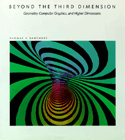 This is the cover of Thomas F. Banchoff's book, Beyond
the Third Dimension. (He also has a very interesting artwork
home page.)
This is the cover of Thomas F. Banchoff's book, Beyond
the Third Dimension. (He also has a very interesting artwork
home page.)
THE PUNCH LINE
SPACES: Dimensionality and imaginary worlds.
We need to think about the kinds of spaces
Everything on a screen takes place in some kind of a space. The "desktop" on your computer screen is a space. Many things in your mind take place in some kind of space. Even audio takes place in some space.
We can design any kinds of spaces that we want for our interactive systems and imaginary worlds. But few people are aware of how many choices there are.
Some people want to simulate three-dimensional space (so-called "virtual reality"). I think the issue is not to simulate reality, but to design spaces that are mentally useful for our ideas and our work. These may take very different form from the spaces we have ever seen before.
EUCLIDEAN SPACES
By a "Euclidean space" I mean standard geometry with diagonals-- pieces
of paper (2D Euclidean space), cubes, spheres (3D Euclidean space).
The human mental system is built around 3D Euclidean structure.
However, screens are 2D
and information is ND. (Meaning N, or any number of, dimensions.
A looping 2D Euclidean space-- a sheet that loops without twisting-- is called a cylinder.
The surface of the earth, or any sphere, is not Euclidean (since parallel lines meet); it is Riemannian. But we have no difficulty understanding this.
2 1/2 D (Ron Baecker)
"Two and a half D" is Ron Baecker's term for flat objects seeming to move over one another, like pieces of paper. Some cheap TV animation seems to be 2 1/2 D. Windows on the computer desktop are 2 1/2 D. "Sprites", characters or pictures that float across video games (especially older video games), are often 2 1/2 D.
PARADOXICAL SPACES
By "paradoxical spaces" I mean spaces that violate our ordinary ideas of space. A cylinder, which is a Euclidean sheet in a loop, does not violate our expectations-- but when you see a pattern repeating in the background of a game-- which can be the same thing-- you may be surprised.
A sheet that loops in two dimensions is a torus; many texture maps are toruses, meaning that they repeat in two dimensions.
DISCRETE SPACES
Discrete spaces, broken up into individual cells, are very common. An old-fashioned typewriter page is a discrete space, as is the old-fashioned screen of an Apple II. If you check closely enough, your own computer screen is a discrete space. Fixed-size fonts on any screen, too, exist in a discrete grid.
Spreadsheet exists in a discrete grid.
ZigZag
exists in a discrete grid-- but a very paradoxical one.
Serious N-Dimensionality
I won't worry you with serious n-dimensionality right now. But the standard reading is the humorous 19th-Century novel Flatland: a Romance of Many Dimensions, by "A SQUARE" (Edwin A. Abbott).
Professor Thomas F. Banchoff, of Brown University, has spent his career
on the visualization of structures in multiple dimensions:  This is the cover of Thomas F. Banchoff's book, Beyond
the Third Dimension. (He also has a very interesting artwork
home page.)
This is the cover of Thomas F. Banchoff's book, Beyond
the Third Dimension. (He also has a very interesting artwork
home page.)
THE PUNCH LINE
Here is the important point: we can construct any spaces that we want,
out of these raw spatial ideas, to represent anything we want. The
question is: what spaces are useful, beneficial, understandable.